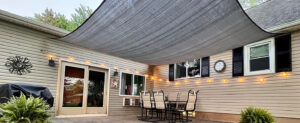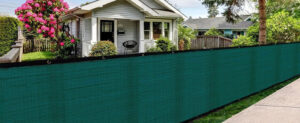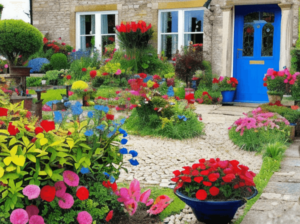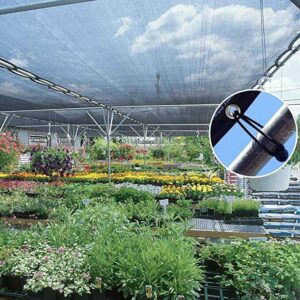Contact Us: [email protected] WhatsApp: +86-1365-3417-367
Introduction
Are you tired of birds ravaging your carefully tended garden, snatching away your hard-earned produce before you get a chance to enjoy it? If so, you’re not alone.
Birds can be a major nuisance for gardeners, causing damage to crops and frustration for those who put in the effort to grow them.Fortunately, there’s a solution: bird netting.
In this comprehensive guide, we’ll explore everything you need to know about bird netting for gardens. From understanding what bird netting is to learning how to install and maintain it effectively, we’ll cover all the bases to help you protect your garden from avian invaders.
Let’s dive in and discover how bird netting can transform your gardening experience!
Understanding Bird Netting
What is bird netting?
Bird netting is a protective barrier made from mesh material, typically nylon, polyethylene, or metal, designed to keep birds out of specific areas such as gardens, orchards, and vineyards. It acts as a physical barrier, preventing birds from accessing plants and crops while still allowing sunlight, air, and water to pass through.
Types of bird netting:
There are several types of bird netting available, each with its own advantages and considerations:
- Nylon bird netting: Lightweight and flexible, nylon netting is easy to install and suitable for covering small areas.
- Polyethylene bird netting: Durable and weather-resistant, polyethylene netting is ideal for larger garden plots and long-term use.
- Metal mesh bird netting: Made from stainless steel or aluminum, metal mesh netting provides maximum durability and protection against larger birds and pests.
How does bird netting work?
Bird netting creates a physical barrier that prevents birds from accessing plants and crops. The mesh material is stretched over the garden area and secured in place to create a barrier that birds cannot penetrate. When installed correctly, bird netting effectively deters birds without causing harm to them or the plants.
Benefits of Bird Netting for Gardens
Bird netting offers a range of benefits for gardeners looking to protect their crops from avian pests:
- Protecting crops from bird damage: Birds can cause significant damage to crops by pecking at fruits, vegetables, and seedlings. Bird netting creates a physical barrier that prevents birds from accessing plants, reducing the risk of damage and loss of yield.
- Preventing birds from accessing fruits and vegetables: Many gardeners grow fruits and vegetables for their own consumption, but birds often beat them to the harvest. Bird netting creates a protective barrier around plants, preventing birds from reaching the fruits and vegetables and ensuring a bountiful harvest for the gardener.
- Minimizing the spread of bird-borne diseases: Birds can carry and transmit diseases that can affect both plants and humans. By keeping birds out of the garden with bird netting, gardeners can reduce the risk of disease transmission and maintain a healthy growing environment for their crops.
- Environmentally friendly solution: Unlike chemical repellents or deterrents, bird netting is a non-toxic and environmentally friendly solution for bird control. It does not harm birds or other wildlife and allows gardeners to protect their crops without resorting to harmful chemicals.
- Long-term investment: While bird netting requires an initial investment in materials and installation, it offers long-term benefits for gardeners. With proper maintenance, bird netting can last for multiple growing seasons, providing reliable protection year after year.
Overall, bird netting is a versatile and effective solution for protecting gardens from bird damage. Its benefits extend beyond crop protection, offering peace of mind for gardeners and promoting a healthy and sustainable growing environment.
How to Install Bird Netting in Your Garden
Installing bird netting in your garden is a straightforward process, but it requires careful planning and attention to detail to ensure optimal effectiveness.
Follow these step-by-step instructions to install bird netting and protect your garden from avian pests:
- Measure your garden area
Begin by measuring the dimensions of your garden area to determine how much bird netting you’ll need.
Consider the length, width, and height of the area you want to protect, as well as any obstacles such as trees or structures. - Choose the right type of bird netting
Select a bird netting material and mesh size that is appropriate for your garden and the types of birds you’re trying to deter.
Nylon netting is lightweight and easy to handle, while polyethylene netting offers durability and weather resistance.
Metal mesh netting provides maximum protection against larger birds and pests. - Prepare the garden area
Clear any debris, weeds, or obstructions from the garden area where you’ll be installing the bird netting.
Trim back any overhanging branches or vegetation that could provide access points for birds. - Install support structures
If necessary, install support structures such as posts, stakes, or hoops to provide a framework for the bird netting.
Ensure that the supports are securely anchored in the ground and spaced evenly around the perimeter of the garden. - Secure the bird netting
Unroll the bird netting and drape it over the support structures, ensuring that it covers the entire garden area.
Use clips, ties, or stakes to secure the netting in place, taking care to seal any gaps or openings where birds could enter. - Anchor the bottom of the netting
To prevent birds from accessing the garden from below, anchor the bottom of the netting to the ground using stakes, weights, or buried edges.
Ensure that the netting is taut and securely fastened to prevent birds from squeezing underneath. - Inspect and adjust as needed
Once the bird netting is installed, inspect it carefully for any gaps, tears, or loose areas. Make any necessary adjustments or repairs to ensure that the netting provides complete coverage and protection for your garden.
By following these steps, you can install bird netting in your garden effectively and enjoy the benefits of a bird-free growing environment.
Maintaining Bird Netting for Long-Term Use
Proper maintenance is essential to ensure that your bird netting remains effective and provides long-term protection for your garden.
Follow these tips to maintain your bird netting and prolong its lifespan:
- Regular cleaning: Regularly inspect the bird netting for dirt, debris, or other contaminants that may accumulate over time.
Use a mild detergent solution and a soft brush or cloth to gently clean the netting, taking care not to damage or tear it in the process. - Repairing damage promptly: Inspect the bird netting regularly for any signs of damage, such as tears, holes, or loose seams.
Repair any damage promptly using patch kits or repair tape designed specifically for bird netting.
Addressing small issues early can prevent them from worsening and compromising the effectiveness of the netting. - Checking for wear and tear: Monitor the condition of the bird netting regularly to check for signs of wear and tear, such as fraying edges or stretched mesh.
Replace any sections of netting that show significant wear or damage to maintain optimal protection for your garden. - Securing the netting: Ensure that the bird netting remains securely fastened to the support structures and anchored to the ground at all times.
Periodically check the tension of the netting and tighten or adjust as needed to prevent sagging or gaps where birds could enter. - Storing properly during off-seasons: During periods when the garden is not in use, such as winter months or off-seasons, remove the bird netting and store it properly to protect it from damage and prolong its lifespan.
Store the netting in a clean, dry area away from direct sunlight and moisture, and avoid folding or creasing it to prevent damage to the mesh. - Inspecting support structures: Regularly inspect the support structures, such as posts, stakes, or hoops, to ensure that they remain sturdy and intact.
Replace any damaged or deteriorated support structures promptly to maintain the integrity of the bird netting installation.
By following these maintenance tips, you can ensure that your bird netting remains in good condition and provides reliable protection for your garden season after season.
Alternative Methods for Keeping Birds Out of Your Garden
While bird netting is an effective solution for keeping birds out of your garden, there are alternative methods worth considering.
Explore these alternative bird control methods to find the best solution for your garden.
- Scare tactics and deterrents: Visual deterrents such as reflective tape, scare balloons, and predator decoys can help deter birds from entering your garden by creating a sense of threat or danger.
Auditory deterrents such as wind chimes, ultrasonic devices, or distress calls can also be effective at scaring birds away from your garden. Natural predators and habitat modifications: Introducing natural predators such as cats, dogs, or birds of prey into your garden can help deter birds by creating a hostile environment.
Modifying the habitat with features such as bird spikes, bird repellent plants, or bird repellent sprays can make your garden less appealing to birds and encourage them to seek food and shelter elsewhere.- Decoys and repellents: Decoys such as fake owls, snakes, or predators can help deter birds by mimicking natural threats. Repellents such as bird gel, bird repellent spray, or bird spikes can create a barrier that birds find unpleasant or uncomfortable, deterring them from landing or roosting in your garden.
Physical barriers and exclusion methods: Installing physical barriers such as bird spikes, bird wire, or bird repellent gel strips can prevent birds from landing or roosting on surfaces such as fences, ledges, or rooftops.
Exclusion methods such as bird netting, bird screens, or bird cages can create enclosed areas that birds cannot access, protecting specific plants or areas of your garden from bird damage.Habitat management and food source control: Removing sources of food such as bird feeders, compost piles, or fallen fruit can help reduce bird activity in your garden by eliminating the attraction.
Managing habitat features such as water sources, nesting sites, or sheltered areas can make your garden less hospitable to birds and encourage them to seek food and shelter elsewhere.
By exploring these alternative methods for keeping birds out of your garden, you can find the best solution to suit your needs and preferences.
Experiment with different tactics and combinations to create a bird-free environment that allows your garden to thrive.
Frequently Asked Questions about Bird Netting for Gardens
1. What types of birds does bird netting deter?
Bird netting is effective at deterring a wide range of bird species, including sparrows, starlings, pigeons, robins, and blackbirds. The mesh size of the netting is designed to prevent birds of all sizes from accessing plants and crops, making it an ideal solution for protecting gardens from avian pests.
2. Is bird netting safe for use around pets and wildlife?
Yes, bird netting is safe for use around pets and wildlife when installed properly. The mesh material is lightweight and flexible, posing no threat of entanglement or harm to animals that come into contact with it. However, it’s essential to monitor pets and wildlife to ensure they do not become trapped or injured in the netting.
3. Can bird netting be reused season after season?
Yes, bird netting can be reused season after season with proper care and maintenance. By storing the netting properly during off-seasons and conducting regular inspections for damage or wear, you can extend its lifespan and continue to enjoy its benefits for years to come.
4. How effective is bird netting in preventing bird damage?
Bird netting is highly effective in preventing bird damage to plants and crops when installed correctly. The physical barrier created by the netting prevents birds from accessing the garden area, significantly reducing the risk of damage and loss of yield. Proper installation and maintenance are key to ensuring the effectiveness of bird netting in protecting your garden.
Conclusion
Bird netting is a versatile and effective solution for protecting your garden from avian pests and preserving the health and vitality of your plants and crops.
By creating a physical barrier that prevents birds from accessing the garden area, bird netting helps to minimize damage, reduce the spread of bird-borne diseases, and promote a healthy growing environment.
In this comprehensive guide, we’ve covered everything you need to know about bird netting for gardens, from understanding how it works to learning how to install and maintain it effectively.
We’ve explored the benefits of bird netting, alternative bird control methods, and answered frequently asked questions to help you make informed decisions for your garden.
Whether you’re a seasoned gardener looking to protect your crops or a novice exploring bird control options for the first time, bird netting offers a reliable and environmentally friendly solution that allows you to enjoy the fruits of your labor without interference from avian intruders.
So why wait? Take action today and invest in bird netting to safeguard your garden and enjoy a bountiful harvest for years to come.





